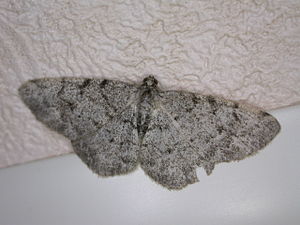Gray alder bark clamp
| Gray alder bark clamp | ||||||||||||
|---|---|---|---|---|---|---|---|---|---|---|---|---|

Gray alder bark spider ( Aethalura punctulata ) |
||||||||||||
| Systematics | ||||||||||||
|
||||||||||||
| Scientific name | ||||||||||||
| Aethalura punctulata | ||||||||||||
| ( Denis & Schiffermüller , 1775) |
The gray alder bark spanner ( Aethalura punctulata ), also called white-gray alder tree spanner or alder spanner , is a butterfly ( moth ) from the spanner family (Geometridae).
features
The moths of the Grauer Alder-Rindenspanner have a wingspan of 24 to 29 millimeters (30–35 millimeters). The upper sides of the wings are ash gray to light brownish gray in the basic color. There are also darkened and lightened specimens. The drawing is also variable. The often visible three transverse lines are black and usually become stronger towards the front edge. According to the variability of the basic color and the drawing, a whole series of formae have been described.
- f. trilineata Bruckova, 1945: with three clear transverse lines
- f. marginata Lempke, 1953: The border area on the front and rear wings is darkened
- f albescens Prout, 1915: basic color of the wings almost uniformly whitish
- f. intermedia Lempke, 1953: wings dark gray, drawing clearly
- f. cinerea Leraut, 2002: wings ash gray, drawing clearly
- f. obscuraria Paux, 1901: wings uniformly black-gray
- f. costijuncta Lempke, 1970: A broad black band has developed on the front edge of the fore wing
- f. anastomosaria Lempke, 1970: First and second transverse lines on the forewing are complete
Slight sexual dimorphism is observed. The females have slightly more rounded wings.
The egg, which is green to orange-red, is flattened at the top. The surface is covered with 30 to 24 longitudinal zigzag lines and 30 to 32 transverse lines. The six- to seven-leaved micropyle sits in a deep depression.
The caterpillar is brownish, greenish, greenish-gray or purple-brown in color. The longitudinal lines and the incisions of the segments are usually yellowish or whitish, often enlarged like spots. The longitudinal lines are often interrupted or dissolved into elongated points.
The pupa is red-brown to dark red-brown and stocky. The cremaster is frustoconical.
Geographical occurrence and habitat
The species occurs in almost all of Europe with the exception of central and northern Scandinavia, northern Scotland and the Mediterranean islands. In the east the distribution area extends to western Siberia and the Caucasus.
The species prefers loosened alder-ash floodplain forests on moist to wet locations. It is only distributed locally in Central Europe, but mostly common in the corresponding biotopes. It occurs from the plain to medium mountain regions. In the Alps it rises up to 1600 m above sea level.
Way of life
The gray alder cortex forms up to two generations a year, depending on the altitude and the location climate, whereby the second generation is usually incomplete. The moths fly from late March to late June and the second, mostly incomplete generation in July and August. In the north of the distribution area and in climatically unfavorable places, only one generation is formed whose moths fly from the end of March to the beginning of July. The moths are nocturnal and are attracted to artificial light sources. During the day the moths rest on alder or birch trunks. They sit across the trunk and imitate lichens that grow on the tree trunks.
After breeding, the duration of the ice stage is given as 16 days, the caterpillar stage with 20 to 25 days.
The caterpillars feed on the leaves of birch ( Betula ) and alder ( Alnus ). The pupa hibernates in the ground.
Danger
The gray alder cortex is not endangered in Germany.
swell
Individual evidence
- ↑ a b Red List
- ↑ a b Peder Skou: The geometroid moths of North Europe (Lepidoptera, Drepanidae and Geometridae). 348 S., Brill, Leiden, 1986
- ^ Ian Kimber: Guide to the moths of Great Britain and Ireland
- ↑ a b Leraut (2009: p. 188)
- ↑ Walter Forster , Theodor A. Wohlfahrt : The butterflies of Central Europe. Volume 5: Spanner. (Geometridae). Franckh'sche Verlagshandlung, Stuttgart 1981, ISBN 3-440-04951-5 .
- ↑ Ebert (2003: pp. 505–507)
literature
- Günter Ebert (Ed.): The butterflies of Baden-Württemberg. Volume 9. Moths VII. Geometridae 2nd part . 1st edition. Ulmer, Stuttgart (Hohenheim) 2003, ISBN 3-8001-3279-6 .
- Patrice Leraut: Geometrid moths . In: Moths of Europe . 1st edition. Volume II. NAP Editions, 2009, ISBN 978-2-913688-09-4 (English).
Web links
- www.lepiforum.de Taxonomy and photos
- Moths and Butterflies of Europe and North Africa (English)
- Aethalura punctulata in Fauna Europaea